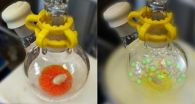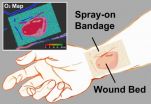(Press-News.org) DURHAM, N.C. -- A Duke University team has found that nanoparticles called single-walled carbon nanotubes accumulate quickly in the bottom sediments of an experimental wetland setting, an action they say could indirectly damage the aquatic food chain.
The results indicate little risk to humans ingesting the particles through drinking water, say scientists at Duke's Center for the Environmental Implications of Nanotechnology (CEINT). But the researchers warn that, based on their previous research, the tendency for the nanotubes to accumulate in sediment could indirectly damage the aquatic food chain in the long term if the nanoparticles provide "Trojan horse" piggyback rides to other harmful molecules.
The results appear online in the journal Environmental Science: Nano.
Carbon nanotubes are rapidly becoming more common because of their usefulness in nanoelectric devices, composite materials and biomedicine.
The Duke study was done using small-scale replications of a wetland environment, called "mesocosms," that include soil, sediments, microbes, insects, plants and fish. These ecosystems-in-a-box are "semi-closed," meaning they get fresh air and rainwater but don't drain to their surroundings. While not perfect representations of a natural environment, mesocosms provide a reasonable compromise between the laboratory and the real world.
"The wetland mesocosms we used are a much closer approximation of the natural processes constantly churning in the environment," said Lee Ferguson, associate professor of civil and environmental engineering at Duke. "Although it's impossible to know if our results are fully accurate to natural ecosystems, it is clear that the processes we've seen should be considered by regulators and manufacturers."
Ferguson and his colleagues dosed the mesocosms with single-walled carbon nanotubes and measured their concentrations in the water, soil and living organisms during the course of a year. They found that the vast majority of the nanoparticles quickly accumulated in the sediment on the "pond" floor. However, they found no sign of nanoparticle buildup in any plants, insects or fish living in the mesocosms.
While this is good news for humans or other animals drinking water after a potential spill or other contamination event, the accumulation in sediment does pose concerns for both sediment-dwelling organisms and the animals that eat them. Previous research has shown that carbon nanotubes take a long time to degrade through natural processes -- if they do at all -- and any chemical that binds to them cannot easily be degraded either.
"These nanoparticles are really good at latching onto other molecules, including many known organic contaminants," said Ferguson. "Coupled with their quick accumulation in sediment, this may allow problematic chemicals to linger instead of degrading. The nanoparticle-pollutant package could then be eaten by sediment-dwelling organisms in a sort of 'Trojan horse' effect, allowing the adsorbed contaminants to accumulate up the food chain.
"The big question is whether or not these pollutants can be stripped away from the carbon nanotubes by these animals' digestive systems after being ingested," continued Ferguson. "That's a question we're working to answer now."
INFORMATION:
This research was supported by the National Science Foundation, the Environmental Protection Agency under the National Science Foundation cooperative agreement EF-0830093, the Center for the Environmental Implications of Nanotechnology and the Environmental Protection Agency's Science to Achieve Results (STAR) program (RD833859).
"Fate of single walled carbon nanotubes in wetland ecosystems." Schierz, A., Espinasse, B., Wiesner, M.R., Bisesi, J.H., Sabo-Attwood, T., Ferguson, P.L. Environmental Science: Nano, Sept. 2014. DOI: 10.1039/c4en00063c.
Computer modelling of the human eye, the brain of a rat and a robot could revolutionise advances in neuroscience and new technology, says a QUT leading robotics researcher.
Dr Michael Milford from QUT's Science and Engineering Faculty says the new study uses new computer algorithms to enable robots to navigate intelligently, unrestricted by high-density buildings or tunnels.
"This is a very Frankenstein type of project," Dr Milford said.
"It's putting two halves of a thing together because we're taking the eyes of a human and linking them up with the brain of a rat.
"A ...
An international group of researchers led by Dr. Warren E. Piers (University of Calgary) and Dr. Heikki M. Tuononen (University of Jyväskylä) has been able to isolate and characterize an important chemical intermediate whose existence has, so far, only been inferred from indirect experimental evidence.
Chemical reactions rarely go from starting materials to final products in one single step, but instead they progress through a number of intermediates. In many cases the intermediates are not stable enough to be studied by conventional characterization methods, which thwarts ...
Philadelphia, PA, October 1, 2014 – Patients with increased inflammation, including those receiving cytokines for medical treatment, have a greatly increased risk of depression. For example, a 6-month treatment course of interferon-alpha therapy for chronic hepatitis C virus infection causes depression in approximately 30% of patients.
Omega-3 fatty acids, more commonly known as fish oil, have a long list of health benefits, including lowering the risk of heart disease and reducing triglyceride levels. These nutritional compounds are also known to have anti-depressant ...
When appointing a new leader, selectors base their choice on several factors and typically look for leaders with desirable characteristics such as honesty and trustworthiness. However once leaders are in power, can we trust them to exercise it in a prosocial manner?
New research published in The Leadership Quarterly looked to discover whether power corrupts leaders. Study author John Antonakis and his colleagues from the University of Lausanne explain, "We looked to examine what Lord Acton said over 100 years ago, that 'Power corrupts and absolute power corrupts absolutely.'"
To ...
Chicago, October 1, 2014 – Patients receiving lungs from donors whose cause of death was asphyxiation or drowning have similar outcomes and long-term survival as patients receiving lungs from traditional donors, according to a study in the October2014 issue of the Annals of Thoracic Surgery.
Key points:
Lungs from donors whose cause of death was asphyxiation or drowning can be safely transplanted into patients with end-stage lung disease.
Patient survival rates were not affected when lungs from cases involving asphyxiation and drowning were used.
The researchers note ...
Chicago, October 1, 2014 – Patients undergoing coronary artery bypass grafting (CABG) surgery may not have to follow a strict blood sugar management strategy after surgery, according to a study in the October 2014 issue of the Annals of Thoracic Surgery.
Key points
Liberal management of a patient's blood sugar levels following CABG surgery leads to similar survival and long-term quality of life as achieved through stricter blood sugar management.
The findings applied to all patients, regardless of diabetes status.
The results may encourage hospitals to consider ...
Despite advances, millions of children worldwide still die before their fifth birthday, with complications from preterm birth and pneumonia together killing nearly 2 million young children in 2013, according to a study led by the Johns Hopkins Bloomberg School of Public Health.
Their report, published online Oct. 1 in The Lancet, examines what caused an estimated 6.3 million children under the age of five to die in 2013, one-third fewer than the 9.9 million estimated to have died around the world in 2000. While preterm births and pneumonia were also the top killers in ...
A major medical discovery by scientists at The University of Nottingham could lead to the development of an entirely new type of painkiller.
A drug resulting from the research, published in the journal Neurobiology of Disease, would offer new hope to sufferers of chronic pain conditions such as traumatic nerve injury, for which few effective painkillers are currently available.
The work, led by Dr Lucy Donaldson in the University's School of Life Sciences, in collaboration with David Bates, Professor of Oncology in the University's Cancer Biology Unit, focuses on a ...
Cancer vaccines have recently emerged as a promising approach for killing tumor cells before they spread. But so far, most clinical candidates haven't worked that well. Now, scientists have developed a new way to deliver vaccines that successfully stifled tumor growth when tested in laboratory mice. And the key, they report in the journal ACS Nano, is in the vaccine's unique stealthy nanoparticles.
Hiroshi Shiku, Naozumi Harada and colleagues explain that most cancer vaccine candidates are designed to flag down immune cells, called macrophages and dendritic cells, that ...
WASHINGTON, Oct. 1—Inspired by a desire to help wounded soldiers, an international, multidisciplinary team of researchers led by Assistant Professor Conor L. Evans at the Wellman Center for Photomedicine of Massachusetts General Hospital (MGH) and Harvard Medical School (HMS) has created a paint-on, see-through, "smart" bandage that glows to indicate a wound's tissue oxygenation concentration. Because oxygen plays a critical role in healing, mapping these levels in severe wounds and burns can help to significantly improve the success of surgeries to restore limbs and physical ...


